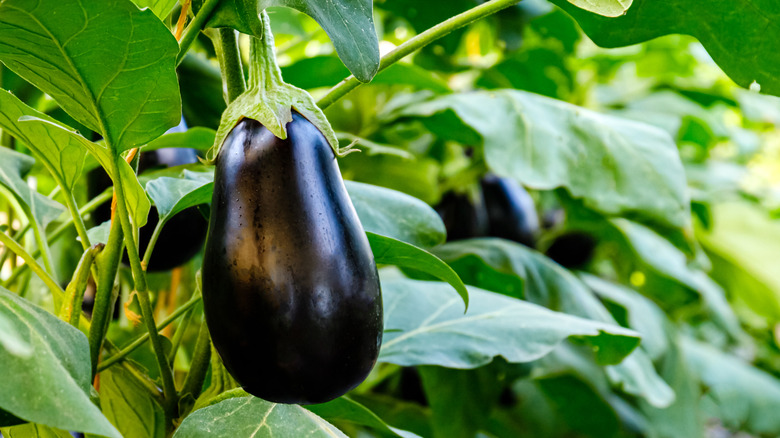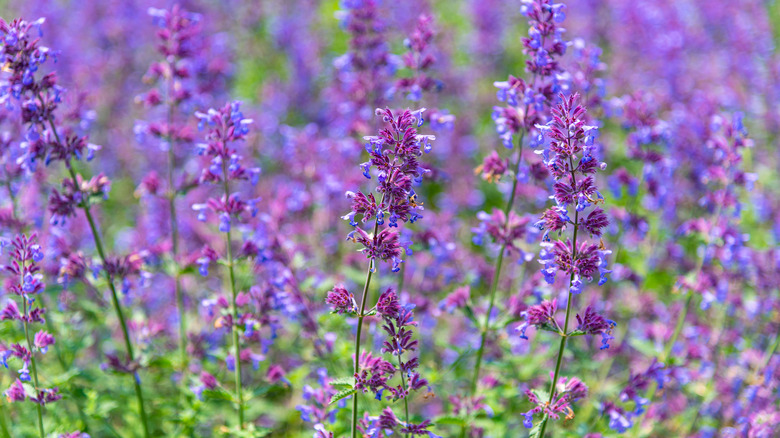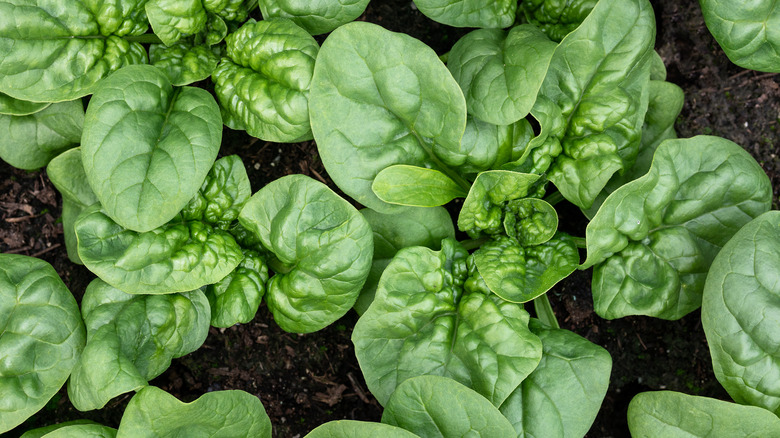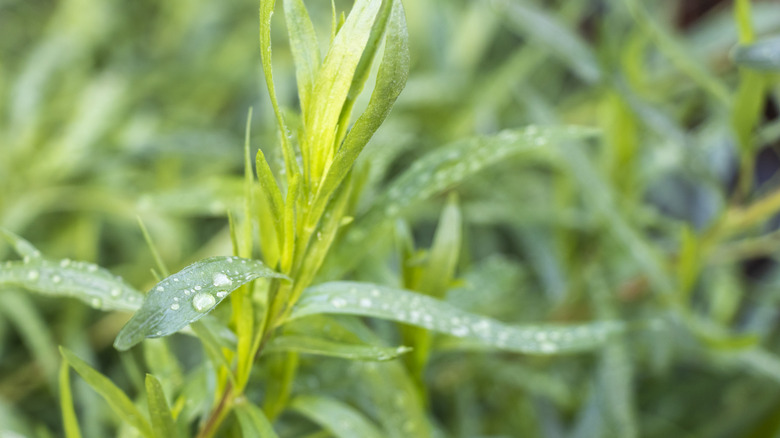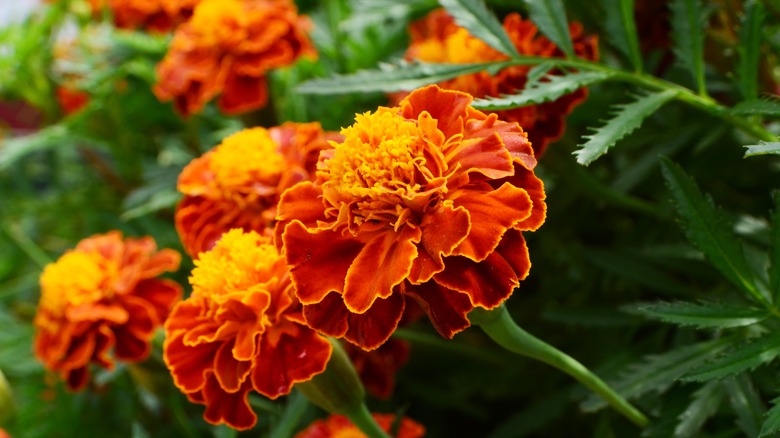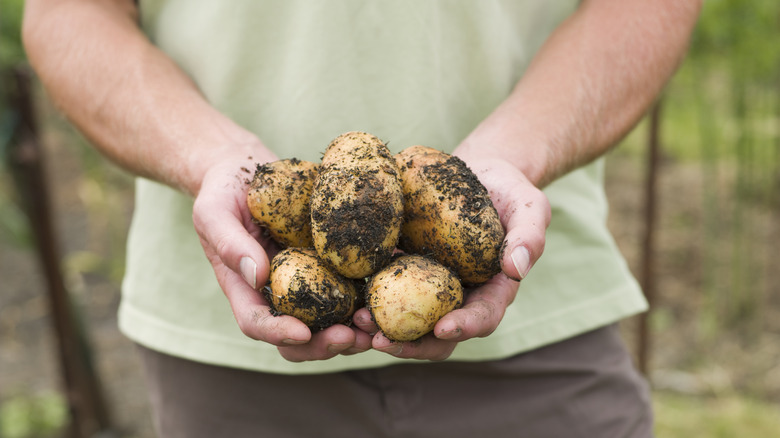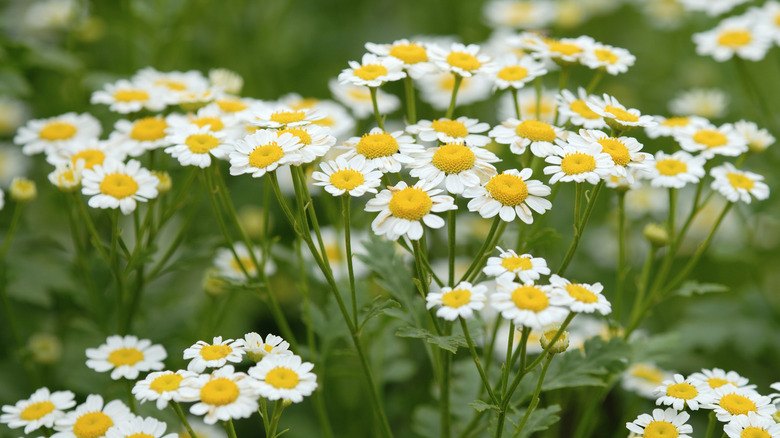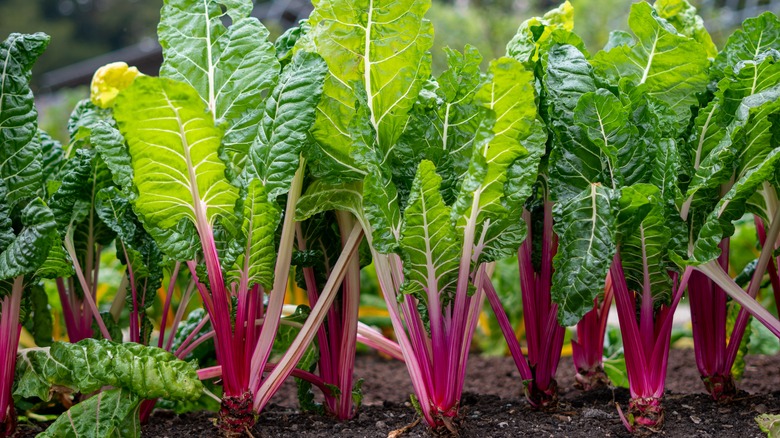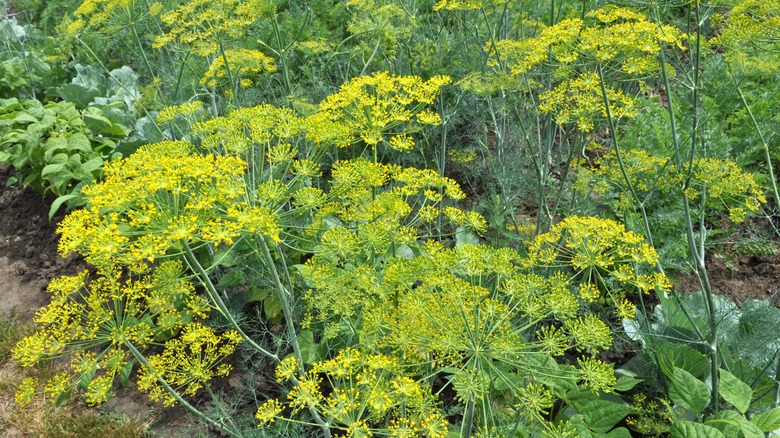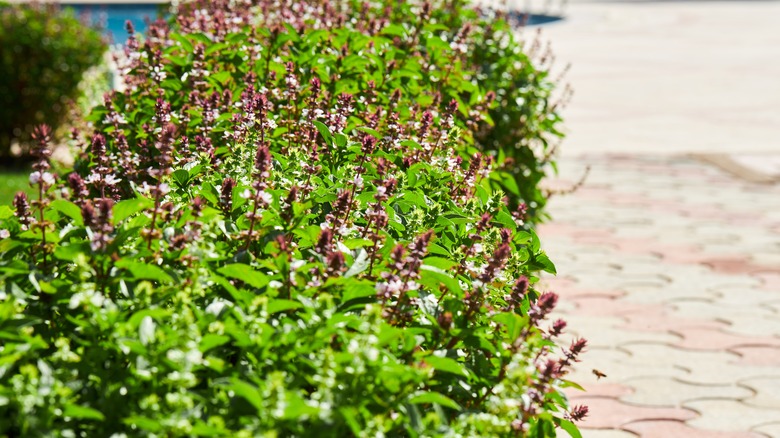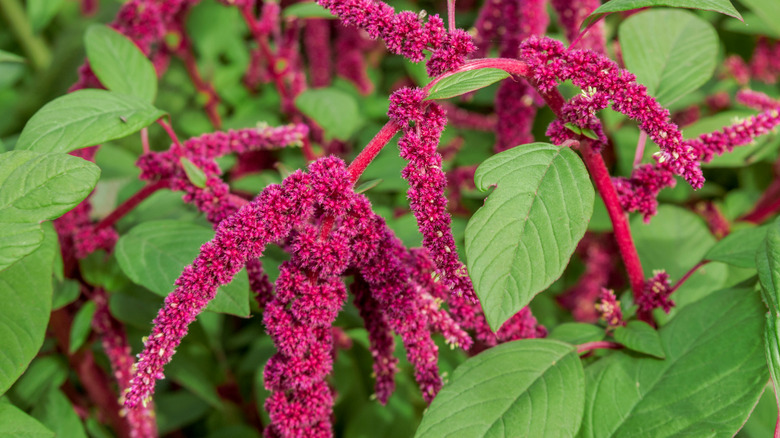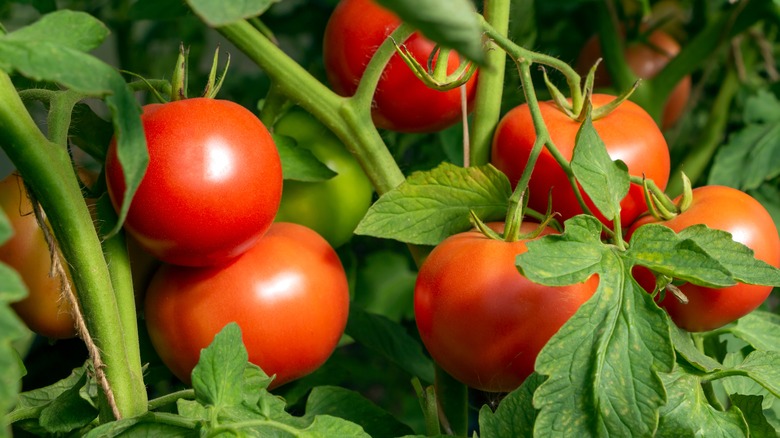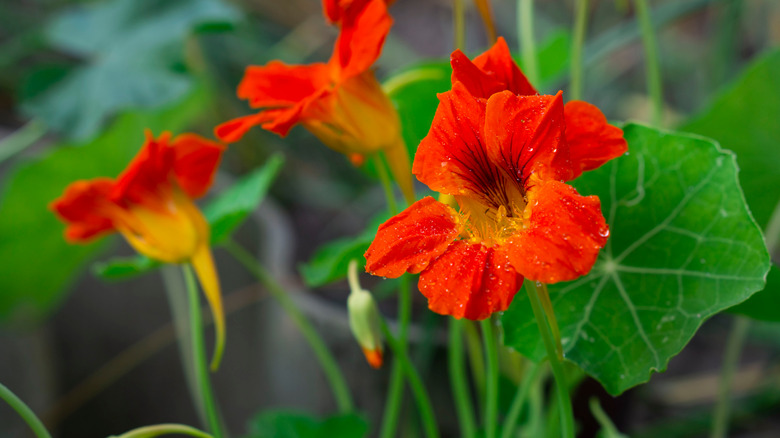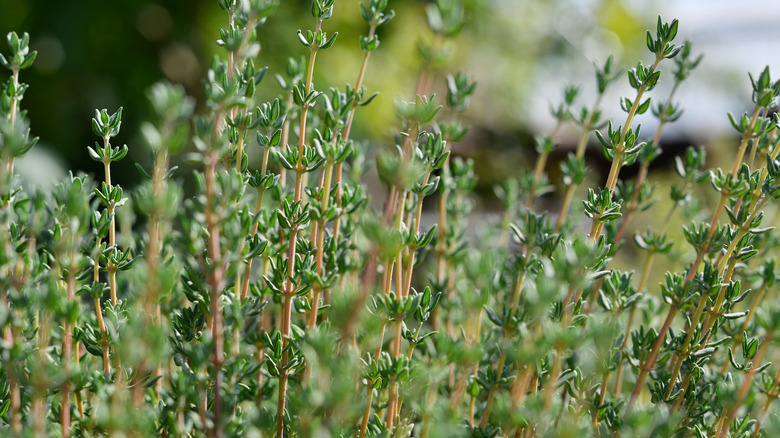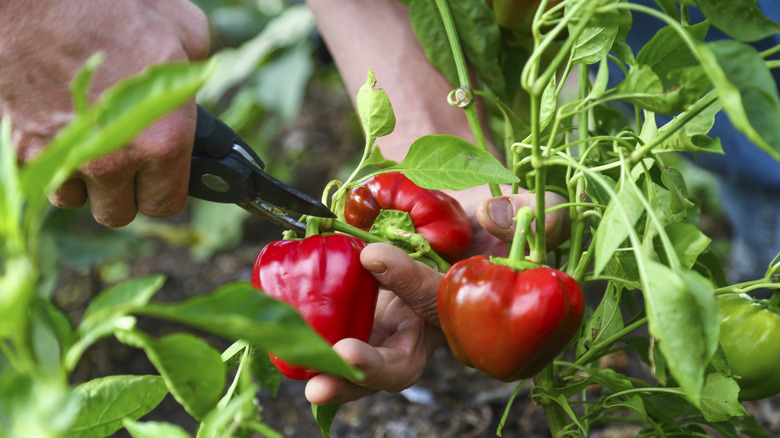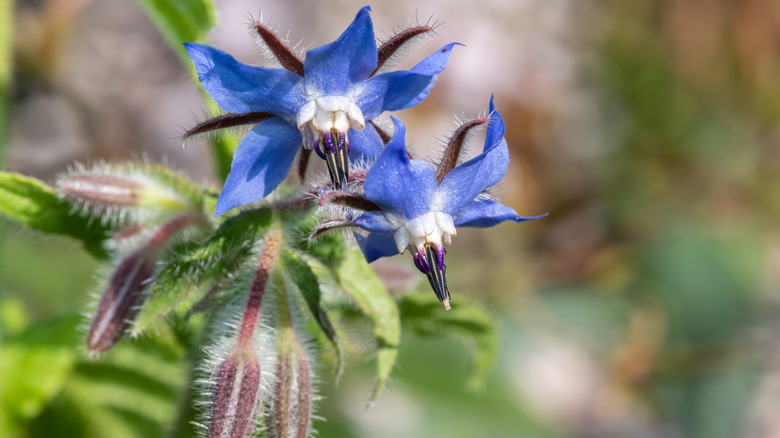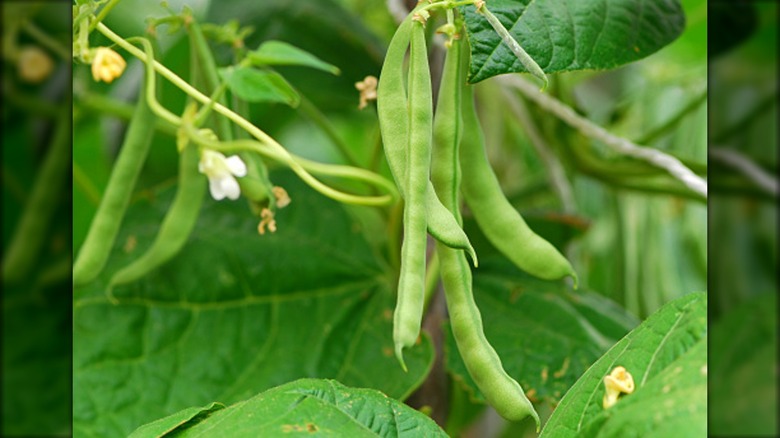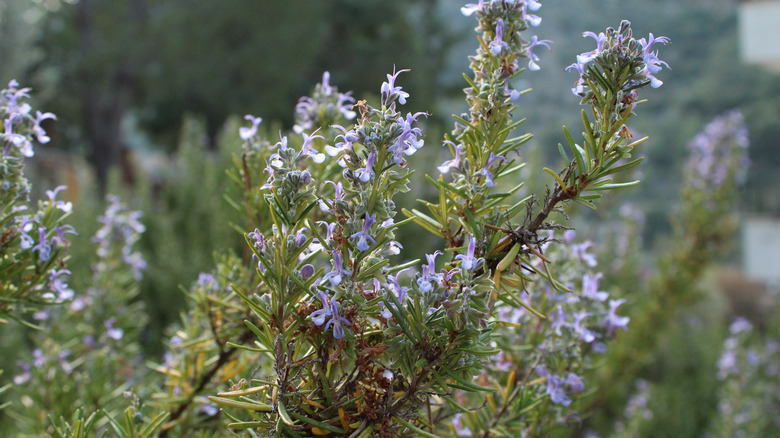Companion Plants That Will Pair Perfectly With Your Eggplant
Vegetable gardens can be a pain to maintain, but that doesn't stop us from raising all kinds of crops throughout the growing season. Still, there is something we can do to cut down on our garden chores – companion planting. It's a popular method of positioning certain outdoor plants together, which lets them help each other in the garden. One might attract pollinators, act as a living mulch, or provide shade to delicate leaves. While another fixes elements like nitrogen in the soil, releasing chemicals that speed up growth, or deter pests.
A member of the Solanaceae family, the eggplant (Solanum melongena) is a summer-blooming crop plant that grows in evenly moist, fertile, and well-draining soil. It grows well with several different types of plants, especially herbs and other fruits and vegetables. Commonly, eggplants need help protecting themselves from insects that damage their leaves, stems, fruits, and roots. Thankfully, nematodes, aphids, armyworms, and some beetle species are all manageable with the help of a few companion plants.
1. Catnip
Catnip plants (Nepeta cataria) are of use to eggplants because of their scent. Like other members of the mint family, catnip has pungent leaves that ward off several pests looking to eat your eggplants. As a bonus, this herb shares the same needs for direct sunlight and well-draining soil, so the pair can grow right next to each other. Just be sure that the catnip, which grows aggressively, is not overtaking your eggplants.
Bloom Season: Spring
USDA Growing Zone: 3 to 7
Growing Conditions: Full sun
Soil Type: Well-draining
Size: 2 to 3 feet tall and wide
2. Spinach
Spinach (Spinacia oleracea) grows happily with eggplants because they won't compete with each other. Spinach enjoys a bit of shade, which the taller Solanum species can provide. And, the eggplants can benefit from the mulch-like effect that the dense spinach plants with shallow roots offer. Planted as partners, these summer-blooming veggies help each other grow more healthily.
Bloom Season: Summer
USDA Growing Zone: 2 to 11
Growing Conditions: Full sun to partial shade
Soil type: Rich and well-draining
Size: 6 to 12 inches tall and wide
3. French tarragon
French tarragon (Artemisia dracunculus 'Sativa') is a fragrant herb known for its short and thin foliage that resembles rosemary leaves. Planted nearby eggplants, it's thought to enhance the flavor of the purple produce, though more research needs to be done. What we're certain of, however, is that French tarragon will scare away pests that are repulsed by its scent.
Bloom Season: Summer
USDA Growing Zone: 3 to 7
Growing Conditions: Full sun
Soil Type: Rich and well-draining
Size: 1 to 3 feet tall and wide
4. Marigolds
Marigold flowers (Tagetes patula) are crop plants' best friend. Nearly every garden vegetable, including eggplant, can benefit from the orange flower's spicy scent, which deters pests from entering your garden. Eggplants are particularly susceptible to nematodes, but marigold's chemical-releasing roots will do the trick to keep the nematode population under control.
Bloom Season: Spring to fall
USDA Growing Zone: 2 to 11
Growing Conditions: Full sun to partial shade
Soil Type: Moist and well-draining
Size: 1 foot tall and wide
5. Potato
Potato plants (Solanum tuberosum) are in the same family as eggplants: the nightshade family. The related garden vegetables have very similar growing requirements and grow quite well together as a result. Both delicious plants are grown as annuals in home gardens that provide direct sunlight, well-draining soil, and plenty of space to spread.
Bloom Season: Summer to fall
USDA Growing Zone: 2 to 11
Growing Conditions: Full sun
Soil Type: Moist, sandy, and well-draining
Size: 1 to 2 feet tall and 1 foot wide
6. Chamomile
The chamomile plant (Matricaria chamomilla) can be a helpful addition to an herb garden, but it's even more beneficial to plant next to eggplants. Like most pungent plants, chamomile scares off harmful insects while also attracting good ones to pollinate flowers and eat pests. Specifically, the flowers, which can also be used to make a soothing tea, bring bumblebees to your garden.
Bloom Season: Summer and fall
USDA Growing Zone: 2 to 8
Growing Conditions: Full sun to partial shade
Soil Type: Well-draining
Size: 12 to 30 inches tall and 1 to 8 inches wide
7. Swiss chard
Although it's unwise to plant leafy brassica species such as cabbage and kohlrabi near eggplants due to their need for differing soil pH levels, swiss chard (Beta vulgaris) makes for a great eggplant companion. Swiss chard, which is a leafy plant used for its yummy foliage, is closely related to beet plants and grows in similar conditions as eggplants.
Bloom Season: Summer
USDA Growing Zone: 2 to 11
Growing Conditions: Full sun to partial shade
Soil Type: Organic and well-draining
Size: 1 to 2 feet tall and wide
8. Dill
Dill (Anethum graveolens) is an annual herb that attracts parasitic wasps that are known to feed on common garden pests. This includes one type, called armyworms, that often threaten eggplants as they feed on their flowers, leaves, and fruit. By planting dill near the Solanum species, you can fend off the destructive armyworm and welcome in more eggplants come harvest season.
Bloom Season: Summer
USDA Growing Zone: 2 to 11
Growing Conditions: Full sun
Soil Type: Rich, light, and well-draining
Size: 3 to 5 feet tall and 2 to 3 feet wide
9. Oregano
Like catnip, oregano (Origanum vulgare) is also a member of the mint family with many of the same benefits. Planted in a vegetable garden, the herb is reported to keep the space healthy while it attracts insects that help control pest populations. When you're looking for a plant to naturally increase your garden's ability to fend off disease and harmful bugs, oregano is where you should start.
Bloom Season: Summer
USDA Growing Zone: 3 to 9
Growing Conditions: Full to partial sun
Soil Type: Well-draining
Size: 2 feet tall and wide
10. Amaranth
Amaranth (Amaranthus caudatus) is a popular edible plant in certain places around the world, however, it doesn't seem to get enough love in the United States. Regardless of this, amaranth actually grows well as an annual in most places. It simply needs some sunlight, water, and warm weather conditions. Even if you don't harvest it as a grain crop or leaf vegetable, it's still ornamental, and it looks great next to eggplants.
Bloom Season: Summer
USDA Growing Zone: 2 to 11
Growing Conditions: Full sun to partial shade
Soil Type: Moist and well-draining
Size: 3 to 5 feet tall
11. Tomatoes
Another nightshade species, tomatoes (Solanum lycopersicum), are unsurprisingly well-suited to growing with eggplants. The two fruits, which are typically treated as vegetables, have nearly identical growing requirements. Because of this, however, if you grow the two together, be sure that they are provided with enough space and compost. Both will grow widely and need a lot of nutrients to do so properly.
Bloom Season: Summer
USDA Growing Zone: 10 to 11
Growing Conditions: Full sun
Soil Type: Fertile, moist, and well-draining
Size: Up to 6 feet tall and 3 feet wide
12. Nasturtium
While nasturtiums (Nasturtium spp.) are edible themselves, most gardeners don't grow them for eating. This is because they can instead be used as productive trap plants when they're planted near your edible garden. Aphids love to suck the plant juices out of the leaves and stems of this flowering plant, and while their microscopic bellies fill with nasturtiums' sap, your eggplants are left alone to do their thing.
Bloom Season: Spring to fall
USDA Growing Zone: 2 to 11
Growing Conditions: Full sun
Soil Type: Well-draining
Size: 1 to 10 feet tall and 1 to 3 feet wide
13. Thyme
Like French tarragon, thyme (Thymus vulgaris) is thought to improve the taste of eggplants growing close by. However, in the same way, these claims are unsubstantiated. What we do know is that they deter garden moths and keep aphids off eggplants using their aromatic leaves. During their bloom time in the spring and summer, the flowers borne on the thyme plant attract butterflies, bumble bees, and more pollinators.
Bloom Season: Spring and summer
USDA Growing Zone: 5 to 9
Growing Conditions: Full sun
Soil Type: Evenly moist and well-draining
Size: 6 to 12 inches tall and wide
14. Peppers
Even though pepper plants (Capsicum annuum) don't share the same genus as eggplants, they are still in the Solanaceae family and are considered to be nightshades. All types of peppers prefer direct sunlight and well-drained soil to grow in, just like the purple fruit. While the two are great neighbors, you will want to avoid consecutively planting them in the same area over the years which can lead to disease-ridden peppers and eggplant plants.
Bloom Season: Summer
USDA Growing Zone: 4 to 11
Growing Conditions: Full sun
Soil Type: Rich, moist, and well-draining
Size: 1 to 4 feet tall
15. Borage
Borage (Borago officinalis) is commonly used as a companion for fruit and vegetable plants that are susceptible to attacks by pests like tomato hornworms. For the harmful bugs that it can't repel, its flowers attract predatory insects that will eat the pests threatening your eggplants. The blue star-shaped flowers are also known to entice local pollinator species, which may increase the eggplant's yield come harvest time.
Bloom Season: Spring and summer
USDA Growing Zone: 6 to 9
Growing Conditions: Full sun to partial shade
Soil Type: Well-draining and sandy
Size: 3 feet tall
16. Pole beans
Pole beans (Phaseolus coccineus) don't always grow well with others, but this is not the case for eggplant. The legume's ability to fix nitrogen in the soil below allows it to make friends with the Solanum species, which takes advantage of the newly fertile soil and begins to produce more stems, leaves, and fruit for the upcoming harvest.
Bloom Season: Summer to fall
USDA Growing Zone: 7 to 11
Growing Conditions: Full sun
Soil Type: moist, fertile, organically-rich, and well-draining
Size: 8 to 13 feet tall and 3 to 5 feet wide
17. Rosemary
The rosemary plant (Salvia rosmarinus), known for deterring Colorado potato beetles, is a shrub that can be grown on the outskirts of a garden to protect it. The herb is a Mediterranean plant that needs little water or nutrients to grow. With almost no intervention, a rosemary bush planted in full sun and well-draining soil will draw in more pollinators and predatory insects.
Bloom Season: Summer
USDA Growing Zone: 8 to 10
Growing Conditions: Full sun
Soil Type: Light, slightly acidic, and well-draining
Size: 2 to 6 feet tall and 2 to 4 feet wide
